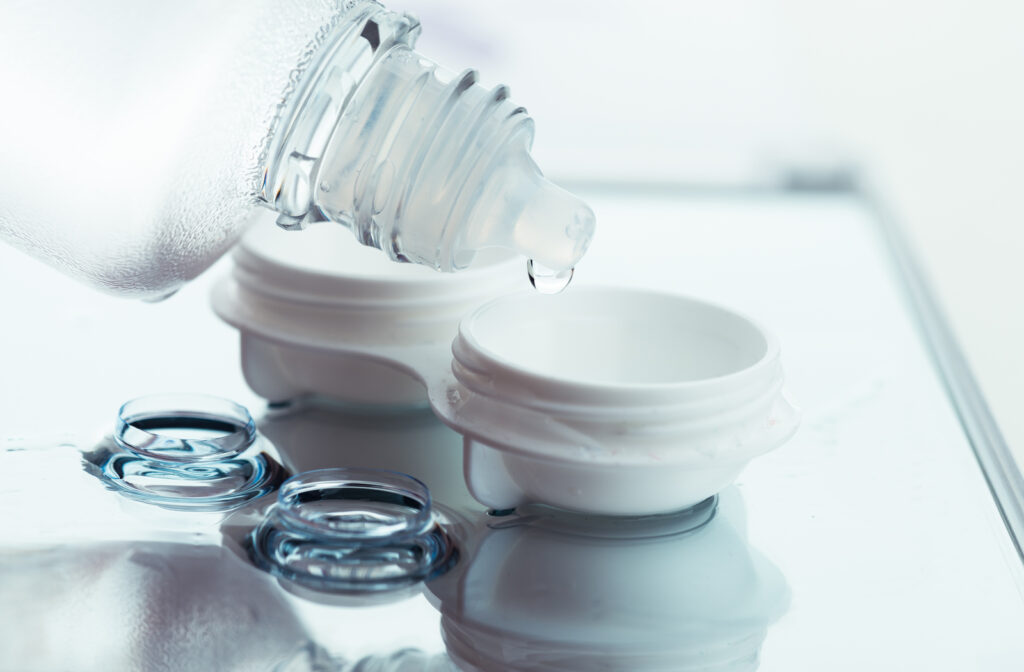If you’ve worn contact lenses before, you know that comfort is always a priority. So it’s important to know that not all lenses are created equal. Depending on the shape of your eyes and your prescription, some contacts will perform better than others.
A contact lens fitting is the only way for the doctor to make sure your eyes are ready for contact lenses. There are benefits beyond just getting the right prescription. Schedule an exam and contact lens fitting to start seeing clearly and comfortably.
Seeing Your Best with Contact Lenses
A contact lens fitting might seem like a bothersome extra step at the eye doctor, but it’s a necessary step that will make all the difference. Because contact lenses sit directly on the front of your eyes, the prescription can vary from that of your eyeglasses. This means that careful measurements must be made to ensure that your contacts will help you see just as well as glasses.
Our optometrist will perform a comprehensive eye exam before conducting a lens fitting. The initial eye exam surveys your general ocular health and looks for signs of eye disease. Wearing contacts can expose your eyes to more dangers, such as debris getting stuck under a lens or an eye infection from a dirty pair of contacts. Contact lens wearers should schedule an eye exam at least once per year.
Getting it Right with a Trial Pair
One of the great benefits of a contact lens fitting is that your eye doctor can recommend a brand for a trial period. Once your fitting is complete we will order a single pair of contacts for you to try out.
We’ll schedule a follow-up exam and make sure that your new lenses are performing exactly as expected before ordering an annual supply. If there are unforeseen complications or they don’t feel quite right, we can move to another option. This saves you money, and potentially a lot of time, in the long run.
Discovering Details With a Lens Fitting
It’s not always easy finding a pair of contacts that fit just right. You may have an eye condition like astigmatism or keratoconus that requires specially shaped contact lenses. Or you may suffer from corneal abrasions (scarring) that make your eyes very sensitive.
And this is why you require a contact lens fitting. A fitting provides a contact lens prescription that caters to the shape and specific needs of your eyes.
Contacts for Astigmatism & Keratoconus
Not all of us have perfectly round eye globes. In fact, about 1 out of 3 people have at least some form of astigmatism. Astigmatism is an irregularly shaped cornea or lens that changes the way light focuses on the back of the eye. Keratoconus is another vision disorder that affects how your eyes grow, creating a cone-like shape of the cornea.
Astigmatism and keratoconus cannot be fully corrected with standard contact lenses. But with advanced corneal topography, the exact shape of your eye’s surface can be mapped. This information is used to select, or in some cases custom-make, contact lenses that address these corneal irregularities. These diagnostics are part of a contact lens fitting.

Consider Scleral Lenses
Many common contact lens brands do not account for people who have sensitive eyes or have experienced eye trauma. Scleral lenses are specialty lenses that vault right over the cornea, which is ideal for some patients. They can make wearing contacts comfortable for people with dry eyes, and may even have therapeutic effects.
Beyond recommending scleral lenses, a contact lens fitting can help determine if you are best suited for other specialty contacts. Prosthetic contact lenses and custom soft lenses could be the perfect match for your eyes if you’ve had problems with more traditional options. Contact lens fittings give us all the information to choose a product that will keep you smiling while you’re seeing clearly.
Investing in Your Eye’s Future
There are so many contact lens options in today’s market, and picking the brand that is best for your eyes is not a choice you should make alone. A contact lens fitting allows our optometrist to take exact measurements of the shape of your cornea. This not only helps you see better and more comfortably, but ensures that the material and shape of your contacts are not doing any long-term damage.
Contact lenses can be such a convenient and practical way to correct your vision. But wearing contacts safely requires just a little extra professional help each year. Getting a contact lens fitting keeps your eyes healthy and ensures you don’t waste money on contacts that aren’t doing their job. So invest in your vision and make sure your contact lenses are the right fit for your precious eyes.



